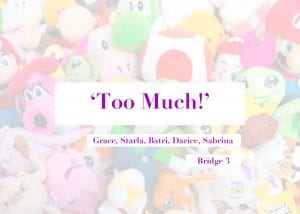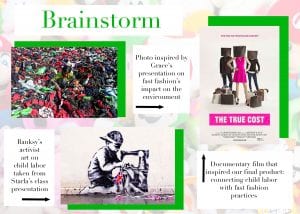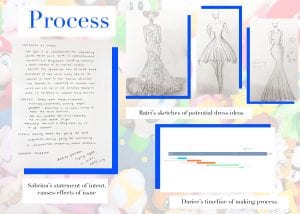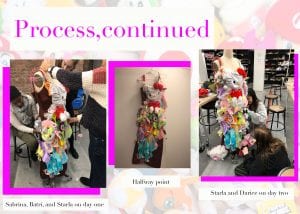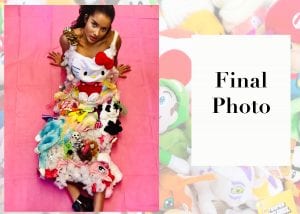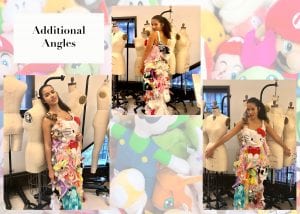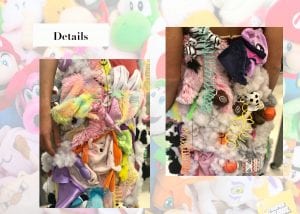Our intention for the ‘Too Much!’ assignment was to communicate our frustration with the dangerous and unfair child labor practices of the textile industry in developing countries. To do so, we collected 20 stuffed animals, other small toys, and a long gown from thrift and discount stores around Midtown, took the stuffing out of the stuffed animals, and completely covered the dress by sewing and gluing to it the deflated stuffed animals and toys. The dress symbolizes how shoppers at fast-fashion retailers like Forever 21 and H&M are exchanging the childhoods of garment factory workers for their desire to follow the fashion industry’s seasonal demands for new, trendy, high-fashion pieces.
Our idea for ‘Too Much!’ was inspired by the 2015 documentary The True Cost, which details the lives of low-wage textile factory workers in developing countries such as India and Bangladesh. A number of us had seen the film prior to brainstorming ideas for the project, and two of our groupmates’ activist art presentations in class about forced child labor and the dangers of fast fashion led us to connect their information to that in The True Cost. Upon further research, we learned that 170 million children around the world, roughly 11% of the global population of children, are currently engaged in child labor to make textiles and garments for the demands of consumers in Europe and the United States. Through further brainstorm and discussion, we decided we wanted to use stuffed animals and toys as our found objects, and after throwing ideas around, we decided that the one with the most ‘shock factor’ was the glamorous and somewhat morbid gown of deflated childhood.
Our group was confident in our ability to find a gown and childhood relics around town, as we had done research for where to find the items for inexpensive prices. However, neither of us were confident in our prior experience with a sewing machine, so we decided to hand-sew each stuffed animal to the dress. Additionally, our original idea included a train of stuffed animals attached to the bottom of the gown, but our restricted time, money, and sewing machine skills unfortunately limited us to just working directly onto the gown.
We resolved our issues with time and sewing experience through use of a hot glue gun to attach the all of the toys to the gown. Additionally, to make up for the lack of a dress train, we attached the excess stuffing all over the empty holes in the dress to create a more voluminous shape, emphasizing the number of childhoods lost to the demands of Western consumerism in the fashion industry. Lastly, though our limited budget only allowed us to buy around 20 stuffed animals, we seam-ripped them butterfly-style so they would cover a greater surface area on the dress.
If we had allocated more time to this project, our group definitely could have worked together to learn how to sew with a machine, which would have allowed us to create the dress out of toys and stuffed animals alone. However, our strategy of sewing the materials directly onto a store-bought gown was still an effective way to portray our interpretation of the art activism assignment, especially because the extra stuffing made the empty spaces of the gown peeking through the stuffed animals and toys less noticeable. Our group members all grew with each other as collaborators and artists through the making process; our constant discussion of thoughts and opinions strengthened our concept and led us to our final product, one we are all proud to have been a part of.

